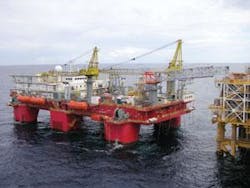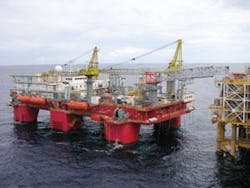Consafe re-emerges as a force in offshore construction support
Afamiliar name - Consafe Offshore - has resurfaced in the flotel and construction support market. In little over a year, the company, based in Gothenburg and part of the JCE Group, has built up a fleet of four accommodation rigs, including one newbuild.
In 1979 and 1980 Consafe, owner of the Safe fleet, was a leading player in the flotel market. The driving force behind the company now, as then, is J Christer Eriksson, the JCE Group chairman. Many of the current staff also served with the company 20 or so years ago, according to chief executive officer Peter Jacobsson.
In the early days of the flotel business, Consafe did much to shape its development. In the 1970s, the company supplied the North Sea’s first purpose-built accommodation modules for fixed platforms, and in 1977, ordered the first purpose-built semisubmersible accommodation rig,Safe Astoria. A further eight units followed from 1979-82. Between 1980 and 1985 Consafe also delivered 10 different types of accommodation barges.
Eriksson returned to the flotel sector in 1997, acquiring Safe Rigs Ltd., which had three accommodation semis. In 1998, the company, now Safe Offshore, merged with Procon Drilling to form Prosafe. Eriksson was the main shareholder in Prosafe until 2004, when he sold his interest and revived Consafe Offshore. The fleet currently consists of the following rigs.
•Safe Astoria, ex Sedco 602 drilling rig (the original Safe Astoria is still in operation but under another name). Following a $65 million conversion at the Keppel FELS yard in Singapore, the number of berths has been increased to 256
•Safe Bristolia, ex Sedco 600. Undergoing refurbishment at Yantai Raffles yard in China, including enlargement of the deck area. Due for delivery in early 2006, it will have 550 beds
•Safe Concordia, the first newbuild flotel for more than 20 years. Built and partly owned by Keppel FELS, it is larger than the other units, with six columns and a 94 m x 36 m main deck. It has a 120-ton crane, dynamic positioning capability, and 376 beds
•Safe Esbjerg, ex Atlantic Esbjerg, Consafe’s first jackup accommodation rig.
Through its affiliated company JCE Group AB, it also has two other offshore interests: a 50% stake inIolair, a semisubmersible construction and quarters platform on long-term charter to Pemex; and a 60% stake in Burntisland Fabrications, which owns the Burntisland and Methil yards in Scotland.
Consafe’s rigs are outfitted to provide efficient support for offshore hook-up operations. The three semis are fitted with telescopic gangways, allowing them to connect, and remain connected, in a wide range of sea-states. Each rig has two cranes and well-equipped workshops. Consafe has also equipped them to meet the higher HSE standards customers require these days, Jacobsson says.
Sakhalin support
In mid-2005 all the rigs had work booked with the exception ofSafe Astoria. Next spring, Safe Bristolia is due to start a $28 million six-month contract for Samsung LLC on the Sakhalin II project off eastern Russian. In May, Samsung issued a letter of intent for five months’ work on the same project for a second rig, Safe Concordia, also starting in spring 2006. The rig will have its bed capacity increased to 630. Both contracts include extension options.
Safe Concordia’s maiden job when it was delivered in March was a three-month contract on ConocoPhillips’ Bayu-Undan field in the Timor Sea, where it used its crane to install a 120-ton mercury module while in DP mode. Following this contract, it was due to return to the shipyard for some outstanding work to be done.
Safe Esbjerg, which in June was undergoing an upgrade in Rotterdam, will take up a three-year contract for Mærsk Oil and Gas in the Danish sector.
With flotel demand strengthening, as recent fixtures at $100,000/day plus indicate, Jacobsson is optimistic that the whole fleet will be gainfully employed in 2006. Moreover, with drilling rig utilization riding high, the reserve pool of unemployed drilling rigs looking for work in the accommodation market - the bane of the flotel market in bad times - has evaporated for the foreseeable future.
Traditionally, the North Sea was the heart of the flotel market, with Mexico providing some demand in recent years. But the geographical extent of the market has grown dramatically, with requirements emerging in eastern Canada, West Africa, Brazil, Sakhalin, India, and the Far East.•
For more information, contact Peter Jacobsson,
Consafe Offshore. Tel +46 31 759 5503,
fax +46 31 759 5520, [email protected],
www.consafeoffshore.com.

